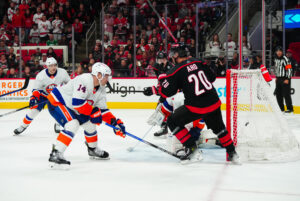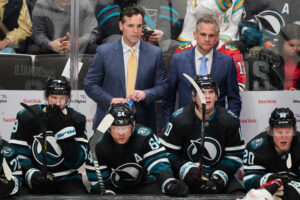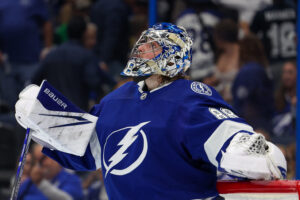The Boston Bruins have the NHL trade deadline finally beyond them. The Bruins were one of the teams expected to make the huge splash. But it seems as they shied away from it. Nevertheless, General Manager Don Sweeney was still able to improve his team. However, a little bit of taste of a missed opportunity remains.
Boston Bruins and Their Trade Deadline
The Bruins were looking for an offensive boost ahead of the trade deadline. They needed to establish the third line and find a solid scorer for a second line. Last week, they acquired Charlie Coyle from the Minnesota Wild in exchange for Ryan Donato and a fifth-round draft pick. Right before the trade deadline on Monday, Boston got forward Marcus Johansson from the New Jersey Devils for a second-round draft pick in 2019 and a fourth-round draft pick in 2020.
Charlie Coyle was brought to Boston mainly for help at the center position. Coyle is not experiencing the best season so far, also because Minnesota played him as a right-winger. Head Coach Bruce Cassidy felt like slotting Coyle back to his natural spot would benefit both his new team and himself.
Coyle was solid in his debut with the Bruins against the St. Louis Blues last Saturday. He centered Peter Cehlarik and David Backes on the third line. Backes, mostly struggling during the current season, had five shots on goal. Coyle was both reliable defensively and creative offensively.
Marcus Johansson came to the Bruins as a second-line winger — at least that was expected. The Bruins were looking for help with their secondary scoring. Johansson, a 28-year-old versatile forward, has put up 12 points (six goals and six assists) in his last 13 games with the Devils. Five of those goals came at even strength. He has plenty of experience of playing with top players like Alex Ovechkin or Nicklas Backstrom from his times with the Washington Capitals.
How Boston Improved With Trade Deadline Acquisitions
The idea of General Manager Don Sweeney was rather clear. Sweeney stressed how important it was for him not to give up either first-round draft pick, top prospect or a roster player. Meanwhile, he wanted to upgrade his team. From this point of view, he accomplished that task perfectly.
Coyle and Johansson combine for more than 1000 games in the NHL and they are still rather young. Boston gave up Ryan Donato and three draft picks in order to get them and that´s not a bad thing either. In terms of what the Bruins paid, they got a very solid return. However, does this really improve the team?
The Boston Bruins needed a third-line center and they got Charlie Coyle. Marcus Johansson used to play in the center position. When needed, he can provide help in that area as well. On the other hand, Boston sought productive second line right winger. Johansson is a left winger, rather.
How would a second line with Jake Debrusk, David Krejci and Johansson look like in comparison with inserting the third piece from their prospect pool? Probably much better. Johansson has both better experience and immediate scoring on a better level than Peter Cehlarik or Danton Heinen.
The Sense of the Missed Opportunities
Adding players like Johansson and Coyle is solid. Without giving up much, the Bruins upgraded. Notwithstanding, they came up short in every other sweepstake. Johansson is not their Plan A. Maybe not even Plan B. But Marcus Johansson was likely their last resort, seeing that the other plans failed.
Mark Stone, Wayne Simmonds, Kevin Hayes and Gustav Nyquist have been linked with the Bruins prior to the trade deadline. None of them ended up in the spoked-B jersey. Boston reportedly finished second or third in each of the races for those players. Dating back to the last off-season, when the Bruins pushed hard for free agents as Ilya Kovalchuk or John Tavares, the taste of frustration can be left with the Bruins organization.
Finishing second has become a pattern for these Boston Bruins. Last season, the Bruins had a great chance to claim Eastern Conference with a home win against the Florida Panthers. But they lost and ended up second — just one point behind the Tampa Bay Lightning. When they met the Bolts later on in the second round of the playoffs, home-ice advantage proved to be the difference, among other things.
The Bruins Go In Two Directions at the Same Time
The Bruins didn’t want to give up any of their high assets. On the other side, they wanted to upgrade. They ended up somewhere in the middle (maybe in the second place). Gustav Nyquist went to San Jose Sharks for a second and third-round draft pick, he reportedly declined a move to Boston. Philadelphia Flyers traded Wayne Simmonds to Nashville Predators for Ryan Hartman and a conditional fourth-round draft pick.
Mark Stone got the Ottawa Senators Erik Brannstrom, Oscar Lindberg and a second-round draft pick. Was that all something the Bruins just could not have matched? Definitely not. High asking price was rumored for these players and as it happened, the Bruins can feel like they missed on few opportunities. Adding Johansson or Coyle is not bad, but adding Simmonds or Stone instead would probably be better.
What’s the positive sign for the Boston Bruins? Their main rivals all remained idle on the trade deadline. Tampa Bay didn’t acquire anybody and neither did the Toronto Maple Leafs (if we don’t count Nic Petan of course). All those players “snubbing” Boston went to the Western Conference. It would be painful to watch mentioned players go to help Bruins divisional rivals.
What To Expect Next from the Boston Bruins
Last season, as already stated above, the Bruins fell short against the Lightning in the playoffs. Compared to the status they found themselves that time last season, they are pretty much the same now. If all remained the same, then we can consider Tampa Bay claiming that playoff series in five games as a statement. The Bruins can hope they learned their lesson.
Don Sweeney certainly learned his lesson. Always reluctant to give up the first round draft pick, he did so last season. How it worked out? Rick Nash wasn’t the game-changer, unfortunately. The past season, Don Sweeney went for it and didn’t succeed. This season, Bruins General Manager decided to do differently in terms of asserting the trade deadline.
The Bruins now seem to have solid four lines. Fully healthy, the Boston Bruins can roll out Brad Marchand, Patrice Bergeron, and David Pastrnak as their top line. That is scary enough and always has been. Jake DeBrusk, David Krejci and Johansson might form the second line. The Swedish winger has never been a bad player and, if he fits well, that line can work as well. The third line, with Charlie Coyle centering whoever is picked there (David Backes, Joakim Nordstrom, Danton Heinen, Peter Cehlarik, etc), seems much improved. Boston has really no problem with their fourth line work.
Is it good enough to overcome four opponents in the playoffs? The Bruins were never really into a full Stanley Cup contender mode entering this season. With the recent moves, they stayed the same. However, they can be a very good underdog in the Eastern Conference. They currently sit second in points “just” 19 points behind the Tampa Bay Lightning.
Main Image Credit:
Post Views: 46






